|
The
people of Spanish America lived in a world infused
with the sacred. Most believed the perceptible world
to be animated by omniscient forces or beings more
powerful than the living—be they God, Jesus
and the saints, ancestors, or the indigenous deities
that Catholics dismissively called "idols." In this section, Vistas explores the manifold ways individuals in New Spain and Perú developed
visual cultures to mark the sites where interaction
with the otherworld took place. It also looks at the
ways people gave expression, through objects, images
and rituals, to their powerful and life-defining interactions
with the divine.
 Without
a doubt, from the 16th century onward, Catholicism
dominated the visual culture of Spanish America devoted
to the otherworldly. Saints and angels, the Virgin
Mary, and Jesus were made visible again and again,
in thousands of manifestations. Image-makers might
be artists of the highest acclaim fulfilling a grand
public commission, or individuals seeking a material
focus for personal devotion. They worked in a myriad
of materials—with paint applied to canvas and
walls, inks on paper, or gesso and wood, tagua nut,
maguey fiber. The most precious materials adorned
figures destined for august patrons and settings:
elite homes, convents or cathedrals. Yet neither the
cost of the materials nor the degree of craftsmanship
determined the spiritual effectiveness of an image.
A humbly sculpted image of wood of the Virgin Mary
could be just as revered as one bedecked in azure
robes and pearls. Without
a doubt, from the 16th century onward, Catholicism
dominated the visual culture of Spanish America devoted
to the otherworldly. Saints and angels, the Virgin
Mary, and Jesus were made visible again and again,
in thousands of manifestations. Image-makers might
be artists of the highest acclaim fulfilling a grand
public commission, or individuals seeking a material
focus for personal devotion. They worked in a myriad
of materials—with paint applied to canvas and
walls, inks on paper, or gesso and wood, tagua nut,
maguey fiber. The most precious materials adorned
figures destined for august patrons and settings:
elite homes, convents or cathedrals. Yet neither the
cost of the materials nor the degree of craftsmanship
determined the spiritual effectiveness of an image.
A humbly sculpted image of wood of the Virgin Mary
could be just as revered as one bedecked in azure
robes and pearls.
 Looking
at visual expressions of the otherworld gives one
view, albeit a carefully focused one, on the larger
landscape of religious belief. For every painting
of the Virgin or statue of a saint, there were thousands
upon thousands of rituals through which people made
connections to the otherworld; these have left little
trace in the visual or historical record. Nuns prayed
silently behind convent walls, people recited their
rosaries before sleep; barefoot farmers lit candles
before prints of saints affixed to the wall. The otherworld
was also evoked in poems read from a book, sermons
heard in church, or songs sung in a plaza. This written
and oral world was the accompaniment to the visual
one glimpsed here. Looking
at visual expressions of the otherworld gives one
view, albeit a carefully focused one, on the larger
landscape of religious belief. For every painting
of the Virgin or statue of a saint, there were thousands
upon thousands of rituals through which people made
connections to the otherworld; these have left little
trace in the visual or historical record. Nuns prayed
silently behind convent walls, people recited their
rosaries before sleep; barefoot farmers lit candles
before prints of saints affixed to the wall. The otherworld
was also evoked in poems read from a book, sermons
heard in church, or songs sung in a plaza. This written
and oral world was the accompaniment to the visual
one glimpsed here.
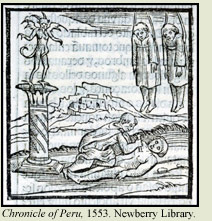 Catholicism
was a religion imposed—often violently—on
America. Long before the conquest, pre-Hispanic societies
had their own highly developed religions and ritual
lives. In the 16th century, early evangelizers, men
of the cloth, arrived with men of the sword and destroyed
thousands, if not tens of thousands, of indigenous
temples and shrines, sacred books and sculptures.
European conquerors degraded native deities, labeling
them “idols” and suppressing their visual
expression. The mendicant friars who were charged
with evangelizing native peoples quickly realized
that one belief system could not be substituted for
another merely by force, and poured their energies
into educating and indoctrinating the young. They
commissioned churches and reset public celebrations
to the Church calendar. Catholicism
was a religion imposed—often violently—on
America. Long before the conquest, pre-Hispanic societies
had their own highly developed religions and ritual
lives. In the 16th century, early evangelizers, men
of the cloth, arrived with men of the sword and destroyed
thousands, if not tens of thousands, of indigenous
temples and shrines, sacred books and sculptures.
European conquerors degraded native deities, labeling
them “idols” and suppressing their visual
expression. The mendicant friars who were charged
with evangelizing native peoples quickly realized
that one belief system could not be substituted for
another merely by force, and poured their energies
into educating and indoctrinating the young. They
commissioned churches and reset public celebrations
to the Church calendar.
 By
the 17th century, Catholicism had taken hold in indigenous
communities. But not surprisingly, Church orthodoxy
was, and still is, perennially modified by local practice
in the Americas (as it was in Europe as well) and
shaped by enduring native beliefs. In fact, one scholar
of Andean religion, Kenneth Mills, speaks of the “many
faces of Christianity,” to emphasize the range
and varied complexion of Christian practices that
developed in Spanish America. By
the 17th century, Catholicism had taken hold in indigenous
communities. But not surprisingly, Church orthodoxy
was, and still is, perennially modified by local practice
in the Americas (as it was in Europe as well) and
shaped by enduring native beliefs. In fact, one scholar
of Andean religion, Kenneth Mills, speaks of the “many
faces of Christianity,” to emphasize the range
and varied complexion of Christian practices that
developed in Spanish America.
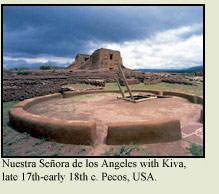 As
Catholics, native peoples As
Catholics, native peoples
did much to define the nature of
otherworldly beings and sites of interaction with
them. In New Spain, the Virgin of Guadalupe left her
image upon a poor Nahua man’s cloak. Slaves
from Africa also had a role in shaping Catholicism:
in the Caribbean and in Brazil, African orishas mingled
with saints. In a number of instances, European-born
or Creole clergy encouraged theater, dance and processions,
allowing local practice to overlap with Catholic performance,
as a way of strengthening the Catholic faith. In other
cases, they accepted indigenous practices with guarded
tolerance. In the Andes, the Jesuits sometimes allowed
khipus—mnemonic devices made of knotted cords—to
be used like rosaries. And in New Mexico, kivas were
built within the walls of a few monasteries. At Pecos,
for instance, the ruined walls of the convento stand
near a subterranean, circular kiva. Modern photographs
like this one, which shows the kiva’s reconstructed
roofing and ladder entryway, reveal the intimate link
between Christian and Puebloan architectural forms
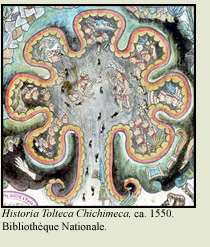 Despite
its power, however, the Church was unable to erase
native
Despite
its power, however, the Church was unable to erase
native
histories, which often recorded moments of contact
with non-Christian or pre-Christian otherworlds—particularly
via ancestors and past heroes, whom many people believed
were active forces in their contemporary worlds. This
Nahua manuscript, called the Historia Tolteca
Chichimeca, painted in the town of Cuauhtinchan
in the mid-16th century offers one example. The scene
describes and depicts the cave of Colhuacatepec, a
primordial point of origin whence founders of the
town of Cuauhtinchan emerged: a Nahua Genesis, not
a Christian one.
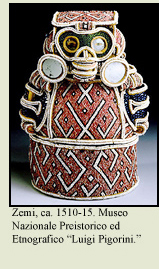 History
was entwined with lives of the dead, and these selfsame
dead were often conduits to otherworldly places and
knowledge. Thus, many indigenous peoples revered the
funerary remains of ancestors, particularly patriarchs
of communities or founders of lineages. In the Caribbean,
zemis were associated with deceased leaders—some,
such as the one here, could hold the ashes of cremated
bodies. And in Andes, the mummies of Inka kings and
queens, as well as local leaders were considered one
type of w’aka, or sacred entity. These mummy
bundles, elaborately dressed, played a large role
in the visual culture of pre-Hispanic times, when
they were taken out in public, fed and honored as
mediators between this world and the next. Yet conquerors
and priests banned many visual expressions of the
ancestors, including zemis and mummy bundles. History
was entwined with lives of the dead, and these selfsame
dead were often conduits to otherworldly places and
knowledge. Thus, many indigenous peoples revered the
funerary remains of ancestors, particularly patriarchs
of communities or founders of lineages. In the Caribbean,
zemis were associated with deceased leaders—some,
such as the one here, could hold the ashes of cremated
bodies. And in Andes, the mummies of Inka kings and
queens, as well as local leaders were considered one
type of w’aka, or sacred entity. These mummy
bundles, elaborately dressed, played a large role
in the visual culture of pre-Hispanic times, when
they were taken out in public, fed and honored as
mediators between this world and the next. Yet conquerors
and priests banned many visual expressions of the
ancestors, including zemis and mummy bundles.
 This
indigenous vision of the dead and their connection
to the otherworld contrasted to that of more orthodox
Catholicism in the colonies. This difference is visible
in the deathbed portraits commissioned in Spanish
America. The purposes of these pictures seems to have
been to commemorate lives well lived and to inspire
members of the community of the living. Neither the
portraits, nor the souls of the people they represented
were objects of devotion, or active forces in the
otherworld. But such portraits, like this one of a
nun bedecked in her habit and crown of flowers, remind
contemporary viewers how much death surrounded the
living—and how many cultural products, both
visual and rhetorical, went into maintaining connections
to the dead and attempting to understand the worlds
where they dwelt. This
indigenous vision of the dead and their connection
to the otherworld contrasted to that of more orthodox
Catholicism in the colonies. This difference is visible
in the deathbed portraits commissioned in Spanish
America. The purposes of these pictures seems to have
been to commemorate lives well lived and to inspire
members of the community of the living. Neither the
portraits, nor the souls of the people they represented
were objects of devotion, or active forces in the
otherworld. But such portraits, like this one of a
nun bedecked in her habit and crown of flowers, remind
contemporary viewers how much death surrounded the
living—and how many cultural products, both
visual and rhetorical, went into maintaining connections
to the dead and attempting to understand the worlds
where they dwelt.
 But
for all the ways Catholic practice was transformed
by folk practices and local beliefs, the Church itself
was not always tolerant. The Inquisition punished
people for practices it deemed idolatrous and worked
to pull belief towards its orthodox teachings. While
its main targets were rarely indigenous people, its
presence was well known. In Lima, the Jesuit-run Casa
de Santa Cruz was both a prison for those accused
by the Inquisition and also a school for native leaders.
Native communities in the countryside from Mexico
through Peru were more often targeted by local bishops,
who sent investigators of “idolatry” to
rout out unorthodox practices. The continued existence,
in places like Huarochiri, Peru, of native healers
and diviners, their use of keros, drums, medicine
bundles, and ceremonial garments (found by Church
investigators) signals that the Church never fully
sanctioned or monopolized all means of access to the
otherworld. But
for all the ways Catholic practice was transformed
by folk practices and local beliefs, the Church itself
was not always tolerant. The Inquisition punished
people for practices it deemed idolatrous and worked
to pull belief towards its orthodox teachings. While
its main targets were rarely indigenous people, its
presence was well known. In Lima, the Jesuit-run Casa
de Santa Cruz was both a prison for those accused
by the Inquisition and also a school for native leaders.
Native communities in the countryside from Mexico
through Peru were more often targeted by local bishops,
who sent investigators of “idolatry” to
rout out unorthodox practices. The continued existence,
in places like Huarochiri, Peru, of native healers
and diviners, their use of keros, drums, medicine
bundles, and ceremonial garments (found by Church
investigators) signals that the Church never fully
sanctioned or monopolized all means of access to the
otherworld.
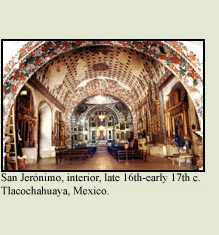 The
powerful need of Spanish Americans to access otherworlds
is no way better attested to than through its landscape—to
this day blanketed with colonial churches and cathedrals.
Through performance of the mass in these churches,
priests conducted rites that turned wine and bread
into the blood and body of Jesus. The accoutrements
for such services—from priestly robes to candlesticks,
altar cloths, and monstrances—set the stage
for invoking the divine. In addition, when mass was
offered, whether in a cloistered convent, a Maya town,
or a magnificent cathedral, images of saints and angels,
Church fathers and royal patrons, Jesus and Mary often
adorned the space. On retablos and ceilings, in side
chapels and choirs, images filled the churches of
Spanish America. With scenes from the Bible, heaven
and hell, churches offered visual, as well as ritual,
access to the Christian otherworld. The
powerful need of Spanish Americans to access otherworlds
is no way better attested to than through its landscape—to
this day blanketed with colonial churches and cathedrals.
Through performance of the mass in these churches,
priests conducted rites that turned wine and bread
into the blood and body of Jesus. The accoutrements
for such services—from priestly robes to candlesticks,
altar cloths, and monstrances—set the stage
for invoking the divine. In addition, when mass was
offered, whether in a cloistered convent, a Maya town,
or a magnificent cathedral, images of saints and angels,
Church fathers and royal patrons, Jesus and Mary often
adorned the space. On retablos and ceilings, in side
chapels and choirs, images filled the churches of
Spanish America. With scenes from the Bible, heaven
and hell, churches offered visual, as well as ritual,
access to the Christian otherworld.
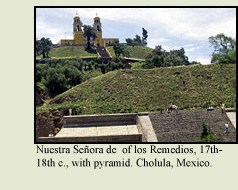 It
was not only buildings that marked the sites of otherworldly
access. In pre-Hispanic Mexico, shrines and temples
were built above caves or to align with the planet
Venus as it swept across the sky. In the Andes, w’akas
could take the form of mountain peaks, streams, and
prominent rock outcroppings. After the Spanish conquest,
colonial churches were often built near, if not upon,
these sacred sites. While these churches undoubtedly
drew on pre-existing understandings of the sacred
landscape, they also tended to displace indigenous
understandings of the otherworld, or subsume those
ideas within Catholic ones. It
was not only buildings that marked the sites of otherworldly
access. In pre-Hispanic Mexico, shrines and temples
were built above caves or to align with the planet
Venus as it swept across the sky. In the Andes, w’akas
could take the form of mountain peaks, streams, and
prominent rock outcroppings. After the Spanish conquest,
colonial churches were often built near, if not upon,
these sacred sites. While these churches undoubtedly
drew on pre-existing understandings of the sacred
landscape, they also tended to displace indigenous
understandings of the otherworld, or subsume those
ideas within Catholic ones.
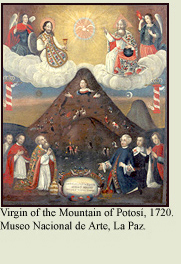 Certain
peoples—beyond the priests ordained by the Church—had
privileged access to otherworlds. Just as Europe produced
visionaries, like Saint Catherine, who dreamed of
a mystic marriage to Christ, or Saint Francis, who
bore the wounds of Jesus on his hands and feet, so
too did Spanish America. Certain local visionaries
captured huge followings and many were promoted by
the Church. Spanish-American born visionaries and
saints, like Saint Rose of Lima, Madre María
de Jesus of Tunja, or Saint Martín de Porras,
reinforced the idea that the portals to the otherworld
could be opened to the living. But, like the visions
themselves, access points to the sacred were also
difficult for Church leaders to fully anticipate.
Miracle working saints, like the Virgin of Ocotlán,
the Virgin of Potosí and the Virgin of Cocharcas,
appeared in surprising places to unlikely visionaries.
And pilgrimages to the shrines of such Virgins became
integral to the landscape and ritual practices of
the sacred in Spanish America. Certain
peoples—beyond the priests ordained by the Church—had
privileged access to otherworlds. Just as Europe produced
visionaries, like Saint Catherine, who dreamed of
a mystic marriage to Christ, or Saint Francis, who
bore the wounds of Jesus on his hands and feet, so
too did Spanish America. Certain local visionaries
captured huge followings and many were promoted by
the Church. Spanish-American born visionaries and
saints, like Saint Rose of Lima, Madre María
de Jesus of Tunja, or Saint Martín de Porras,
reinforced the idea that the portals to the otherworld
could be opened to the living. But, like the visions
themselves, access points to the sacred were also
difficult for Church leaders to fully anticipate.
Miracle working saints, like the Virgin of Ocotlán,
the Virgin of Potosí and the Virgin of Cocharcas,
appeared in surprising places to unlikely visionaries.
And pilgrimages to the shrines of such Virgins became
integral to the landscape and ritual practices of
the sacred in Spanish America.
 Today,
parades and processions are most often held to celebrate
historical events, secular holidays like Independence
Day, and sports victories. In Spanish America, they
were often a way of visually reenacting the porousness
between the otherworld of God and the saints and the
human community. This extraordinary 17th-century painting
shows such a parade during the important feast of
Corpus Christi in Cuzco. In it, Andean leaders lead
an elaborate cart, bearing a statue of Saint Christopher
through the streets of the city. As depicted by the
painter, both the wooden saint and human participants
seem equally alive, equally part of this community. Today,
parades and processions are most often held to celebrate
historical events, secular holidays like Independence
Day, and sports victories. In Spanish America, they
were often a way of visually reenacting the porousness
between the otherworld of God and the saints and the
human community. This extraordinary 17th-century painting
shows such a parade during the important feast of
Corpus Christi in Cuzco. In it, Andean leaders lead
an elaborate cart, bearing a statue of Saint Christopher
through the streets of the city. As depicted by the
painter, both the wooden saint and human participants
seem equally alive, equally part of this community.

|
